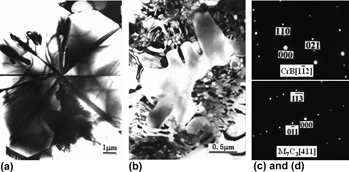Published online by Cambridge University Press: 12 April 2013

Ni–base alloy coatings were fabricated on 45 steel by laser cladding using a CW-CO2 laser system. The microstructure of the coatings was analyzed using optical microscope (OM), scanning electronic microscope (SEM), and x-ray diffractometer (XRD). The phase fractions, phase compositions, and solidification process in the coatings were calculated using Thermo-Calc software and compared with experimental results. The results show that a dense crack- and porous-free coating with good metallurgical bond is obtained under optimal process parameters. The coatings can be divided into three regions: clad zone (CZ), bonding zone, and heat-affected zone of the substrate. The CZ consists of γ-Ni, M7C3, CrB, and Ni3B phases. Based on the calculated results, the solidification process and reaction scheme in the coatings were discussed. The calculated results obtained from Thermo-Calc software agree with the experimental data well. It is beneficial to the coating design for a desirable microstructure and mechanical properties.